Wildflowers, Grasses and Other Nonwoody Plants
Media

Species Types
Scientific Name
Anemone canadensis
Description
White anemone is a showy native wildflower with interesting, deeply toothed leaves. Often occurring in colonies, it spreads easily (even aggressively) from rhizomes and is sometimes cultivated in wildflower gardens.
Media

Species Types
Scientific Name
Camassia scilloides
Description
In spring, wild hyacinth bears an elongated cluster of pale blue flowers with prominent anthers that sway on stalks up to 2 feet tall.
Media

Species Types
Scientific Name
Galium aparine
Description
The tiny white flowers of this native plant are not very memorable, but the curious, sticky-feeling whorls of narrow leaves and lightweight, 4-sided stems make cleavers unique. And then there’s the tiny, round, “Velcro” covered balls of the seeds, which “stick tight” to your socks!
Media

Species Types
Scientific Name
Yucca smalliana, Y. glauca, and Y. arkansana
Description
Three species of yucca grow wild in Missouri. Spanish bayonet was introduced from the Southwest and has escaped from cultivation, but our two soapweeds are native.
Media
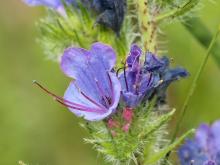
Species Types
Scientific Name
Echium vulgare
Description
A biennial plant with bristly hairs and usually with single stems, viper’s bugloss can grow 2½ feet tall. The flowers are pink in bud, blue to ultramarine later. The protruding stamens are pink.
Media
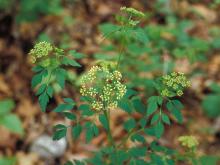
Species Types
Scientific Name
Zizia aurea
Description
Named for its resemblance to a European herb that was popular in Medieval times, golden Alexanders is a native Missouri wildflower with bright yellow flowers arranged in umbrella-like clusters.
Media
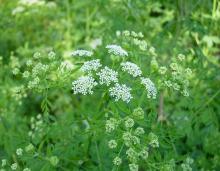
Species Types
Scientific Name
Cicuta maculata
Description
Full grown, water hemlock looks something like a gigantic Queen Anne's lace, but this common, widespread member of the carrot family is the most toxic plant in North America. All parts are deadly. A piece of root the size of a walnut can kill a cow-sized animal.
Media

Species Types
Scientific Name
All true grasses (species in the grass family)
Description
Missouri has 276 species in the grass family, including well-known crop plants and our native prairie grasses. Distinguishing between the species can be difficult, but it’s easy to learn some basics about the group.
Media
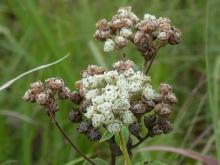
Species Types
Scientific Name
Parthenium integrifolium
Description
A common component of high-quality upland prairie, American feverfew, or wild quinine, is a native wildflower that was used to treat fevers or malaria. It's in the composite family.
Media
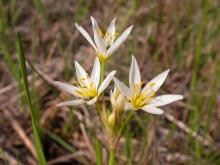
Species Types
Scientific Name
Nothoscordum bivalve
Description
False garlic looks like a wild garlic or onion plant, but it doesn’t smell like one. The flowers can be white, yellowish, or greenish, and they appear in spring and sometimes also fall.
See Also
About Wildflowers, Grasses and Other Nonwoody Plants in Missouri
A very simple way of thinking about the green world is to divide the vascular plants into two groups: woody and nonwoody (or herbaceous). But this is an artificial division; many plant families include some species that are woody and some that are not. The diversity of nonwoody vascular plants is staggering! Think of all the ferns, grasses, sedges, lilies, peas, sunflowers, nightshades, milkweeds, mustards, mints, and mallows — weeds and wildflowers — and many more!





















